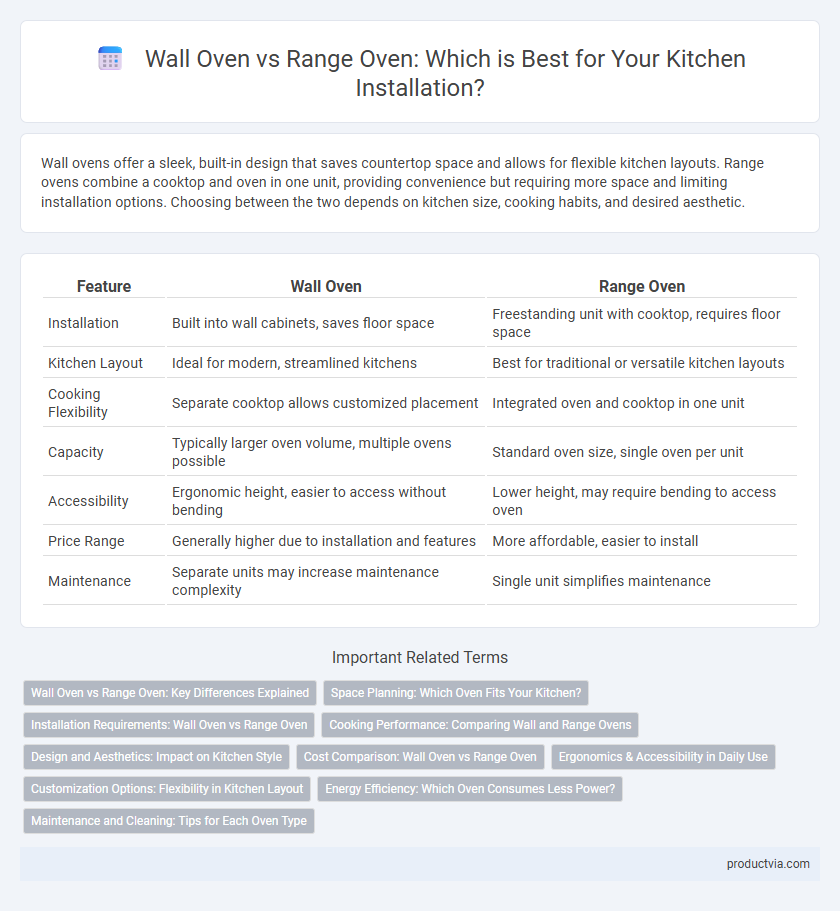Wall ovens offer a sleek, built-in design that saves countertop space and allows for flexible kitchen layouts. Range ovens combine a cooktop and oven in one unit, providing convenience but requiring more space and limiting installation options. Choosing between the two depends on kitchen size, cooking habits, and desired aesthetic.
Table of Comparison
| Feature | Wall Oven | Range Oven |
|---|---|---|
| Installation | Built into wall cabinets, saves floor space | Freestanding unit with cooktop, requires floor space |
| Kitchen Layout | Ideal for modern, streamlined kitchens | Best for traditional or versatile kitchen layouts |
| Cooking Flexibility | Separate cooktop allows customized placement | Integrated oven and cooktop in one unit |
| Capacity | Typically larger oven volume, multiple ovens possible | Standard oven size, single oven per unit |
| Accessibility | Ergonomic height, easier to access without bending | Lower height, may require bending to access oven |
| Price Range | Generally higher due to installation and features | More affordable, easier to install |
| Maintenance | Separate units may increase maintenance complexity | Single unit simplifies maintenance |
Wall Oven vs Range Oven: Key Differences Explained
Wall ovens save kitchen space by being installed into cabinetry at eye level, offering easier access and a modern look, while range ovens combine a cooktop and oven in a single appliance, providing versatility but occupying countertop space. Wall ovens typically provide more precise cooking control and better ergonomic benefits, making them ideal for dedicated baking areas, whereas range ovens are suitable for compact kitchens where stove and oven functions must coexist. The choice depends on kitchen layout, cooking habits, and design preferences.
Space Planning: Which Oven Fits Your Kitchen?
Wall ovens save valuable floor space by mounting directly into cabinetry, ideal for kitchens with limited footprint or open layouts. Range ovens combine stovetop and oven functions in a single unit, requiring dedicated floor space but offering integrated cooking versatility. Selecting the best option depends on kitchen size, layout, and user preference for appliance accessibility and workspace efficiency.
Installation Requirements: Wall Oven vs Range Oven
Wall ovens require built-in cabinetry space and professional installation to ensure proper ventilation and electrical connections, typically needing dedicated circuits and wall reinforcement. Range ovens combine a cooktop and oven in one unit, requiring standard countertop space with standard electrical and gas hookups, making installation more straightforward and often less costly. Choosing between the two depends on kitchen layout, available space, and specific power supply configurations.
Cooking Performance: Comparing Wall and Range Ovens
Wall ovens offer precise temperature control and even heat distribution, making them ideal for consistent baking and roasting performance. Range ovens combine cooktop and oven functions, providing versatile cooking options but sometimes compromising on even heat for complex dishes. Home chefs prioritize wall ovens for specialized cooking, while range ovens suit multi-functional, space-saving kitchen setups.
Design and Aesthetics: Impact on Kitchen Style
Wall ovens offer a sleek, built-in appearance that creates a streamlined and modern kitchen design, seamlessly integrating with cabinetry for a minimalist aesthetic. Range ovens serve as a focal point with their freestanding structure, often incorporating stylish knobs and finishes that complement traditional or industrial kitchen themes. Choosing between wall ovens and range ovens directly influences the kitchen's visual flow and overall style coherence.
Cost Comparison: Wall Oven vs Range Oven
Wall ovens typically cost between $1,500 and $4,000, depending on features and brand, while range ovens generally range from $800 to $2,500. Installation costs for wall ovens are often higher due to custom cabinetry modifications, averaging $500 to $1,200, compared to simpler electrical and gas hook-ups needed for range ovens. Considering both purchase and installation expenses, range ovens tend to be more budget-friendly for kitchen installations.
Ergonomics & Accessibility in Daily Use
Wall ovens offer superior ergonomics by being installed at eye or waist level, reducing the need to bend or reach, which enhances accessibility and safety for daily use. Range ovens are typically lower, requiring users to crouch or bend, potentially causing discomfort during frequent cooking tasks. Choosing a wall oven promotes easier access to dishes, better control visibility, and improved comfort, especially for individuals with mobility challenges.
Customization Options: Flexibility in Kitchen Layout
Wall ovens provide greater customization options by allowing flexible placement at eye level, freeing up countertop space and enabling seamless integration into cabinetry for a streamlined kitchen layout. Range ovens combine a cooktop and oven in one unit, limiting installation locations but simplifying setup and reducing overall appliance footprint. Choosing between a wall oven and range oven depends on kitchen size, design preferences, and desired workflow efficiency.
Energy Efficiency: Which Oven Consumes Less Power?
Wall ovens generally consume less power than range ovens due to their compact design and independent heating elements, which allow for more precise temperature control. Range ovens integrate stove burners that often increase overall energy consumption, especially during simultaneous use. Choosing a wall oven can lead to lower energy bills and a smaller environmental footprint in kitchen installations focused on efficiency.
Maintenance and Cleaning: Tips for Each Oven Type
Wall ovens offer easier access for cleaning since they are installed at eye level, reducing the need for bending and making it simpler to wipe down surfaces and control panels. Range ovens combine stovetop and oven cleaning, requiring attention to both burner spills and oven interior, with removable parts facilitating thorough maintenance. For wall ovens, regularly cleaning door seals and control buttons prevents buildup, while range ovens benefit from routine stovetop drip pan cleaning to avoid stubborn grease accumulation.
Wall oven vs Range oven for kitchen installation Infographic

 productvia.com
productvia.com